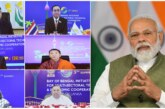Impact of #climatechange on Earth’s #ecosystem, the #livelihood, and well-being of societies is facilitated through the medium of #water. Variations in climate change affect availability and distribution of #rainfall, #meltingofglaciers, #river flows and #groundwater, and further deteriorate #waterquality. Progress on #povertyreduction and #sustainabledevelopment in all #economic, #social and #environmental dimensions can be jeopardized in the wake of inadequate #managementofwaterresources. Adaptation to climate change is closely linked to water and its role in sustainable development. Essential adaptation measures that deal with climate variability and build upon existing land and water management practices have the potential to create resilience to climate change, enhance water security and contribute to development. According to #UNWater, significant policy shifts should be guided by the following principles:
- Mainstream adaptations within the #broaderdevelopment context;
- Strengthening governance and #improvewatermanagement;
- Sharing knowledge and information on climate and adaptation measures, and invest in data collection;
- Building long-term resilience through stronger institutions, and investing in infrastructure and in well-functioning ecosystems;
- Invest in cost-effective and adaptive water management as well as #technologytransfer;
- Local-to-global collaboration among sectoral and multisectoral institutions required;
- #Adaptationstrategies required at the #local, #regional, #national and #global levels.
Besides, there is also need for leveraging additional funds through both increased national budgetary allocations and innovative funding mechanisms for adaptation in water management. Global and national experiences show that responding to the challenges of #climatechangeimpacts on water resources require adaptation strategies at the local, regional, national and global levels. Apart from improving and consolidating their water resources management systems, all the countries should make endeavours to identify and implement relevant strategies, which have positive development outcomes that are #resilienttoclimatechange.
#ClimateChangeIssuesinAsiaPacific
Successful adaptation to a changing climate needs sensible strategies that guide and learn from actions. Strategies are guides to action important for governments, organizations and communities to design appropriate policies and plans as well as build capacities to adapt. Climate change in some situations demands new strategies – for example for dealing with uncertainties and change – but must also draw on experiences and insights from past strategies in development.
For Asia-Pacific countries to survive and thrive in a changing climate, greater efforts are needed to mainstream climate change adaptation into #nationaldevelopmentpolicies, moving away from business as usual practices.
In order to salvage the vulnerable regions from the adverse impact of climate change, some regional forums have been created and the #AsiaPacificClimateChangeForum has been established to address the climate change adaptation related issues of the countries of Asia-Pacific region. The first Forum was held in the first week of June 2010 followed by the second Forum held in the last week of January 2012.
The 3rd Asia-Pacific Climate Change Adaptation Forum was held from 18th – 20th March 2013 in Incheon, Republic of Korea. The main theme of the forum was on “#MainstreamingAdaptationintoDevelopment” with a focus on key selected topics. The Forum was hosted by the Korea Environment Institute (#KEI) in association with the Korea Adaptation Center for Climate Change (#KACCC). The co-organisers were the United Nations Environment Programme (#UNEP), the Institute for Global Environment Strategies (#IGES), the Regional Resource Centre for Asia and the Pacific (#RRCAP), and the Stockholm Environment Institute (#SEI).
The 3rd Adaptation Forum will assist #decisionmakers at all levels of government, in business and communities be more strategic and effective in addressing the challenges of development in a changing climate.
The forum afforded ample opportunities for a range of actors working in different sectors and systems to share their knowledge about successes, and failures, to effectively adapt to climate. The needs and interests of critical and neglected groups were highlighted alongside the need for improving #knowledgemanagement.
The Forum brought together #500climatechangeadaptationexperts and practitioners from across 30 Asia-Pacific countries in government, civil society, academia and the private sector to once again share experiences and find concrete solutions to mainstreaming adaptation planning at the national and community levels. The running theme of mainstreaming climate change adaptation has been the key issue Forum participants have been focusing on and addressing in the past three years.
The participants at the 3rd Forum examined more closely the increasing challenges many countries face in planning and implementing climate change adaptation. They include the lack of access to finance and technologies, as well as inadequate institutional capacity that resonates in most developing nations. About 150 speakers were engaged in six plenary and 26 parallel sessions at the Forum for three days (18 to 20 March 2013) to define these actions and find ways to bolster their adaptive capacities, including by better engaging the private sector and gaining access to global climate change adaptation funding.
The selected findings in the interim are listed below:
- The value of starting with existing policies and learning from experience are now more widely accepted. For example, how local communities have historically adapted to flood regimes is being reconsidered in contemporary landscapes.
- Adaptation strategies need to acknowledge more explicitly that vulnerabilities are dynamic and that multiple uncertainties remain.
- Governance structures need to be more inclusive and adaptive. This will help societies better navigate unprecedented and uncertain climates.
- The private sector is an important group to successful adaptation action. Conversations with business will have to take place in business events and boardrooms.
- Poor, vulnerable and critical neglected groups need to be engaged more directly and meaningfully in adaptation conversations.
- International organisations have an important role in sharing knowledge and experiences across countries. Adaptation knowledge management that is effective increases rates of learning and builds capacity.
- Loss and damage is an issue for all countries considering the recent impacts of extreme weather events like floods and droughts.
#IndiaWaterFoundation, represented by its president, #DrArvindKumar, was invited to make a presentation at the Panel Session on #WaterResourcesManagement. Accordingly, the #IWF presentation was entitled as “#ImpactofClimateChangeonWaterSectorinIndia: #ACaseStudyofMeghalaya.”
#EcologyofWaterinIndia
India has only 2.4% of the world’s landmass, 4% of the total #waterresource, 8.1% of the world’s #biodiversity, 16% of the world’s human as well as 18% of the world’s cattle population. Topographical constraints envisage uneven distribution of precipitation, varying from 100 mm in western Rajasthan to over 11,000 mm at Cherrapunji in #Meghalaya. The availability from surface water and replenishable #groundwater is estimated at 1,869km3, but only about 1,123km3, 690km3 from surface water and 433km3 from #groundwaterresources, can be put to beneficial use.
Of the total the geographical area of India, 12% is flood-prone and 16% is #drought prone. The #burgeoningpopulation, #rapidurbanization and #industrialization has affected the per capita availability of water, which has decreased from 5,177 cubic metres per year (m3/year) in 1951 to 1,654m3/year in 2007 and is likely to be as low as about 1,140 m3/yr in 2050.
The #NationalWaterMission, a part of the #NationalActionPlanonClimateChange (unveiled in June 2008), identifies the threat to #waterresourcesinIndia due to #climatechange in terms of the expected decline in the glaciers and snowfields in the #Himalayas; increased drought-like situations due to the overall decrease in the number of rainy days over a major part of the country; increased flood events due to the overall increase in the rainy day intensity; effect on #groundwaterqualityinalluvialaquifers due to increased #flood and #drought events; influence on groundwater recharge due to changes in precipitation,# evapotranspiration, and increased saline intrusion of coastal and island aquifers due to rising sea levels.
The National Water Mission’s main objective is to achieve #integratedmanagementofwaterresources by conserving water, minimizing wastage and ensuring its more equitable distribution both across and within various States. The Mission proposed a review of the National Water Policy and the 2012 National Water Policy recommends taking the river basin / sub-basin as a unit for planning and management of water resources and proposes that departments / organizations at the Centre and the States be restructured and be made multi-disciplinary. It also proposes the #establishmentofwaterregulatoryauthorities in each State and a national forum to deliberate upon issues relating to water and evolve consensus, cooperation and reconciliation amongst the various States.
However, one of the problems in achieving better management is that the current institutional and legal structures that deal with water in our country are inadequate, fragmented and need urgent reform. The planning, development and management of water resources has to keep pace with current realities. There is need for a broad over-arching national legal framework of general principles on water is necessary to pave the way for essential legislation on water governance in every State. There is also need to reflect on these and other proposals that will help to connect the institutional dots essential to implement an integrated and coherent water policy.
Given the limitations on increasing supply, a large part of any effort to close the demand supply gap must focus on increasing water use efficiency. The National Water Mission sets a target of 20% improvement in #wateruseefficiency. This is particularly critical in the #agriculturalsector, which uses about three fourth of our water resources and where the water use efficiency is low compared to international standards. Management of #irrigationsystems should move away from a narrow engineering-construction-centric approach to a more multi-disciplinary and participatory approach. Incentives needs to be built in to narrow the gap between irrigation capacities created and those being utilized.
On the supply side added emphasis needs to stressed on working on watershed management, rainwater harvesting and groundwater recharge. There is dire need to give renewed vigour to all schemes that involve water. There is also need to address issues that come in the way of convergence and integration of programmes like National Rural Employment Guarantee Scheme, the Integrated Watershed Management Programme, the Programme on #Repair, #Renovation and #Restoration (#RRR) of Water Bodies and the #RainfedAreaDevelopmentProgramme.
The decline in the water table across India is a matter of serious concern.Conservation of groundwater needs to be accorded an urgent priority because we depend on it for more than two thirds of our water needs. The present legal situation gives every land holder the right to pump unlimited quantities of water from a bore well on his own ground. There is no regulation of #groundwater extraction and no coordination among competing uses. Inadequate and sub-optimal pricing of both power and water is promoting the misuse of #groundwater. There is need to move to a situation where ground-water can be treated as a common property resource.
#WaterinNorthEastIndia
The North East region of India, comprising eight states, covers a geographic area of 2,62,179 sq. km constituting 7.9% of India’s total geographical area and a population of 40 million, but the distribution of population is very uneven with over 68% living in the state of #Assam alone. It is a true frontier region as it has over 2000 km of border with #Bhutan, #China, #Myanmar and #Bangladesh.
The region has distinct #climatevariations. The rapid changes in topography result in climate changes within short distances. It is vulnerable to water-induced disasters, fragile geo-environmental setting and economic under-development. The abundant water resources flowing through the #Brahmaputra and #Barakrivers imposes severe distress and costs on the region through frequent flooding and erosive processes.
This region is recognized as one of the world’s #biodiversity hotspots due to its rich natural endowments. The #forestcover is about 52% of the total geographical area and petroleum and natural gas reserves of this region constitute about one-fifth of the country’s total potential. #Agriculture is the mainstay of most of the states.
It has distinct climate variations. The rapid changes in topography result in climate changes within short distances. North-East India is vulnerable to water-induced disasters because of its location in the eastern Himalayan periphery, fragile geo-environmental setting and economic under-development. The powerful hydrological and monsoon regime of the region, especially the #Brahmaputra and the #Barak (#Meghna) river systems are both a resource and a source of vulnerability.
The #NorthEastregion has abundant #waterresources. One third of India’s runoff flows from the Northeast through the Brahmaputra and Barak rivers. The abundant surface water resource imposes severe distress and costs on the region through frequent flooding and erosive processes.
Thus, appropriate #water and #forestdevelopment and management could provide benefits in the form of #hydropower, #agriculture, #inlandwatertransport, #biodiversityconservation, #reducedflooddamageanderosion, longer #damreservoirlife, #forestry, and #ecotourism. These benefits, which would accrue at both regional and local levels, would in turn directly and indirectly increase incomes and enhance #economicgrowth and #povertyreduction.
There is lack of inter-state cooperation and cordination in dealing with water-induced challenges. Appropriate water and forest development and management could provide benefits in the form of hydropower, agriculture, inland water transport, biodiversity conservation, reduced flood damage and erosion, longer dam-reservoir life, forestry, and ecotourism.
#WaterinMeghalaya
#Meghalaya, situated in India’s North-East region, has a #fragileecosystem. Inhabitated by about three million people, Meghalaya encompasses an area of 22,429 kms. It has #Cherrapunjee – one of the wettest places in the world – where the average rainfall during the last 35 years has been 11,952 mm. However, since 2005-06, it has shown a declining trend and experts attribute this to the phenomenon of global warming and deforestation. Nevertheless, short duration heavy rainfall and unprecedented variations in temperature and climate pose a potential destructive effect on #Meghalayasagriculture, its rich #naturalresources, #horticulture, tropical and sub-tropical #fruits and #vegetables etc., which are highly sensitive to climate change.
Until recently, the water situation in Meghalaya was precarious owing to different factors. Cherrapunji, once know as the wettest place on Earth, was turning into a “wet desert” because of adverse impact of climate change. The water of rivers and streams passing through the Jaintia Hills was badly affected by #contaminationofAcidMinesDrainage (#AMD), leaching of heavy metals, and organic enrichment etc. there was absence of institutional mechanism to monitor water quality. Another contributory factor was the lack of inter-state cooperation and convergence between #MinistryofWaterResources, Government of India and #GovernmentofMeghalayainwatersector.
Apart from deficiency of emphasis on #PublicPublicPartnership in water sector, the inadequate utilization of the potential of the #PublicPrivatePrtnership in water sector was another drawback. Concurrently, non-involvement of people in water-related activities at the local and community level in #Meghalaya as well as lack of emphasis on #capacitybuildingofstakeholders and water users in water sector also contributed to water woes.
#IndiaWaterFoundation (#IWF), a New Delhi-based non-profit civil society, offered its cooperation to the Government of Meghalaya in water sector in the realm of capacity building of the people by sensitizing them about water and environment-related issues through education, corner meetings, and arrranging video-shows etc. The IWF provided #watermonitoringkitstotheGovernmentofMeghalaya in early November 2010, to help monitor the quality of water with the help of school children.
While emphasizing on encouraging participation of all stakeholders in the integrated water resources development and management, the #IWF also stressed on need for State Government to adopt integrated approach while formulating the water resources management strategy. It emphasized on urgency for encouraging local indigenous traditional knowledge, such as bamboo pipe irrigation / low cost bamboo filter shallow tubewell / wheel and bucket method of extraction in the rural areas. It also called for disseminating knowledge about techniques/ technologies that improve the efficient use of water at grassroots level of community/village / Panchayat / Block.
Other areas emphasized by #IWF inter alia included: urgency for encouraging use of #HighDensityPolyethylene (HDPE) and #LowDensityPolyethylene (LDPE) pipes in drinking water supply and irrigation to prevent leakages and transit loss; priority to #Waterqualitymonitoring sector; need for strengthening of infrastructures, human resources and upgradation of existing laboratories both in State level and Central level to facilitate micro-level quality monitoring; according top most priority for preservation of catchment area with scheme of #afforestation so that #waterconservation is accelerated and soil erosion is prevented; harnessing Public-Public Partnership (#PPP) model in water sector in the state; and encouraging civil society participation in water sector for better convergence, water quality monitoring etc.
The IWF facilitated convergence between Ministry of Water Resources, Government of India and Department of Water resources, Government of Meghalaya; as well as between #IndiaMetrologicalDepartment under #MinistryofEarthSciences (Govt of India) and Government of Meghalaya. On 22 August 2012, a Memorandum of Understanding (MoU) was signed between #IndiaWaterFoundation and the #MeghalayaBasinDevelopmentAuthority (#MBDA) on cooperation in the field of #waterresourcesinMeghalaya.
Past couple of years has witnessed many ambitious projects being launched by the Government of Meghalaya in water sector. The State Government has launched recently #WaterMission which aims at promoting Integrated Water Resource Management (#IWRM) and building of water-based and water-related livehood and enterprise opportunities for the people.
Water has been made key to State government’s initiative of #IntegratedBasinandLivelihoodDevelopmentProgram (#IBLDP), which addresses various issues of #sustainabledevelopment related to water and natural resource management, #capacitybuilding, #developmentofinfrastructure etc., with climate change perspective. The government has established #DistrictWaterResourcesCouncils at each district level to look at the integrated development of water resources in convergence with relevant schemes. #WaterUsersAssociations (#WUAs) have been set up at the village level to usher in a regime of #demandbasedwatermanagement.
Recently, the state government has circulated its draft of the #WaterAct and #WaterPolicy to all #stakeholdersforconsultations. The government is preparing water harvesting strategies in the form small #multipurposereservoirs to impound water along the cascades and use it for various purposes #drinking, #sanitation, #irrigation, #aquaculture, #microhydel, #ecotourism etc. Besides, #JALKUNDS or ‘stand-alone structures’ are being installed for tapping rainfall for upland irrigation.
These measures undertaken by the state government are welcome but road to #sustainabledevelopment is still very long and more energetic efforts are needed to reach that goal in unison with civil society.
by #DrArvindKumarPresidentIndiaWaterFoundation
Published in SAR Economist|June 2013



